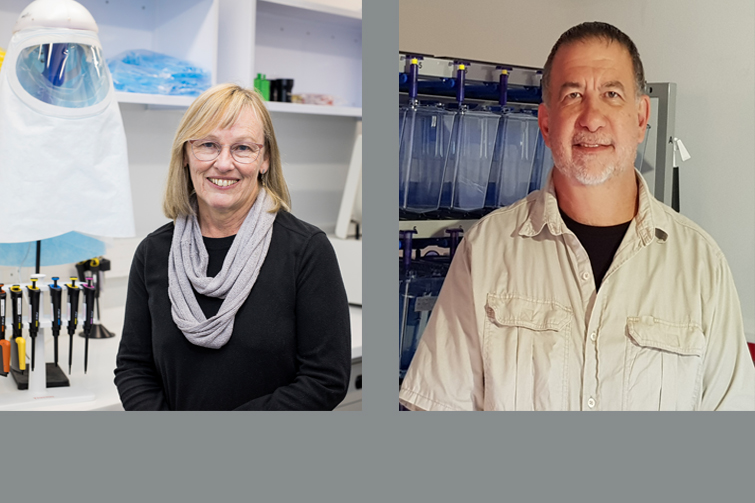31 July 2020
|
Story Andre Damons
|
Photo Supplied
 Prof Felicity Burt and Prof Paul Grobler from the UFS.
Prof Felicity Burt and Prof Paul Grobler from the UFS.
Three scientists from the University of the Free State (UFS), together with authors from other institutions, are part of an international COVID-19 study published in an international peer-reviewed scientific journal recently.
Prof Paul Grobler, Academic Head of
Department: Genetics; Prof Felicity Burt, researcher from the
Division of Virology,
Faculty of Health Sciences and the NHLS, and SARChI (South African Research Chairs Initiative) Research Chair in vector-borne and zoonotic diseases; as well as Prof Trudy Turner from the University of Wisconsin-Milwauwkee, but also an affiliated professor in the Department of Genetics at the UFS, are co-authors of the paper that appeared in Plos One. The study is titled: ACE2 and TMPRSS2 variation in savanna monkeys (Chlorocebus spp.): Potential risk for zoonotic/anthroponotic transmission of SARS-CoV-2 and a potential model for functional studies.
The paper follows an initiative of Prof Chris Schmitt at
Boston University with researchers affiliated to the University of California, Los Angeles, Rutgers University, the Polish Academy of Sciences, the Ministry of Health of the Russian Federation, the University of Antwerp, the Wake Forest School of Medicine, and the University of Wisconsin-Milwaukee. The team used the opportunity presented by previously sequenced genomes to screen for variation in the genes associated with susceptibility to infection with SARS-CoV-2.
Concerns about animal welfare and conservation issues
Prof Grobler, who has been studying vervet monkeys from a conservation perspective for two decades, says considering the impact of COVID-19 on the country, he feels that any aspect that might potentially help to understand the progression and transmission of the disease, as well as unexpected risks – however small – should be investigated.
“Since wildlife management is my field, I am of course also concerned about the potential animal welfare and conservation issues involved. It should, however, be emphasised that while SARS-CoV-2 infection in vervet monkeys has now been shown to be genetically possible, there is no proof of it actually happening in the wild yet.”
“I am sure that much work on COVID-19 and vervets will follow internationally, but this is the first study to describe variation at the genes linked to susceptibility,” says Prof Grobler.
Because of his previous work with vervet monkeys in South Africa and further afield, Prof Grobler was invited by Prof Schmitt to contribute to the manuscript.
“I made some suggestions from a conservation perspective, based on my interpretations and also recent international work that have shown that many primate species may be at risk for SARS-CoV-2 infection and are potentially vulnerable to COVID-19. I also felt that some aspects of the paper would be greatly improved with input from a South African expert in
zoonotic disease to add to the genetic and conservation perspectives, and I therefore requested that Prof Burt also be approached.”
Potential for non-human primates infection
Prof Burt, whose research interests and expertise include the investigation of viruses of zoonotic origin, and/or those transmitted by mosquitoes and ticks that impact human and/or animal well-being – using a
One Health approach – says the study was a collaborative effort between scientists with expertise in a wide range of disciplines, including biological anthropology, genetics, primatology, molecular biology, and virology.
“The concept of One Health encourages collaboration between multiple disciplines, promoting the concept that the interaction between humans, animals, and the environment has an impact on the health of people, animals, plants, and the environment. The outcome is an exciting study that incorporates knowledge from each discipline to investigate the potential susceptibility of non-human primate populations to SARS-CoV-2.”
“The research suggests that there is potential for novel SARS-CoV-2 to infect non-human primates, and that surveillance of non-human primates living in close proximity to human populations is not only warranted, but is actually important for defining risk to both humans and animals,” says Prof Burt.
According to her, the majority of recently emerged viruses, including SARS-CoV-2, were zoonotic in origin. The close proximity of humans and wild non-human primates provides potential for cross-species transmission of pathogens; for some endangered species, this could have devastating effects. Similarly, identifying if non-human primates have the potential to act as intermediate hosts for pathogens with significant public health implications, would be important for understanding zoonotic transmission.
“Novel viruses are continually emerging, and we need to be prepared. A multidisciplinary approach to understanding interactions at the wildlife-human interface will be essential for the prevention of future outbreaks.”